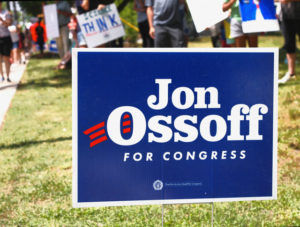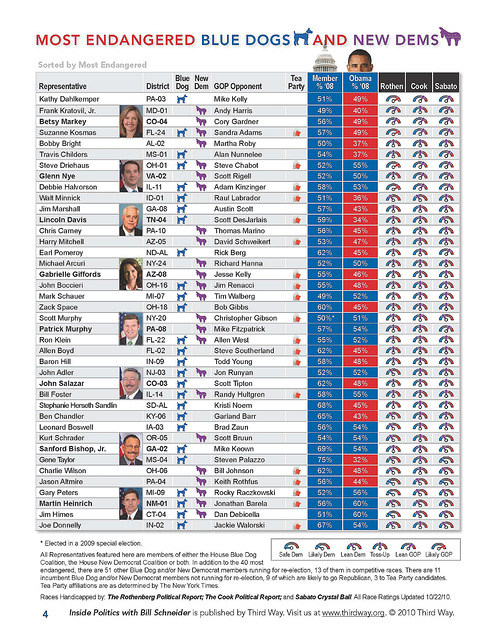A Bit of Blue Dog, a Bit of Bernie
 https://flic.kr/p/dNyycQ
https://flic.kr/p/dNyycQ
Democrats were dealt a fresh round of disappointment earlier this June in Georgia. After raising nearly $24 million dollars in the most expensive House race ever, documentary filmmaker Jon Ossoff lost to former Georgia Secretary of State Karen Handel by 3.7 percentage points. Democrats across the nation hailed this race as a probable breakthrough against the Trump agenda. Here was a candidate who played to the crowd of educated, well-off suburbanites seen as the Democratic Party’s future, running on a centrist platform with a technocratic bent. However, the Democratic wunderkind was tarnished by the fact that much of his money came from out of state, and that he did not even live in the district. In nationalizing this race, Democrats activated a distinctly anti-national party sentiment. Multiple negative ads focused on building links between Jon Ossoff and House Minority Leader Nancy Pelosi, a left-leaning San Francisco Democrat.

https://flic.kr/p/T1fL5m
For all of his money’s worth, Jon Ossoff did worse than un-touted South Carolina 5th district Democratic candidate Archie Parnell, who only lost by 3.1 points in a more Republican, more rural district. Here’s the real twofold kicker: Parnell was a politically moderate, wonky tax attorney with a Wall Street history. In April, James Thompson lost by 6.8 points in Kansas’ 4th district, where Donald Trump won by 27. Thompson made the most progress over last year’s presidential ticket of any congressional special election candidate, with an endorsement from Bernie Sanders’ Our Revolution group and a focus on working class issues. Montana’s Rob Quist, a folksy songwriter, lost by 5.9 in heavily Republican territory with an endorsement from the same group.
Some, like Bernie Sanders activist Nina Turner, urge a uniform shift to the left, while others, like strategist Mark Penn, urge a uniform shift to the center. It appears that special election results both vindicate and invalidate these seemingly dueling hypotheses.
Where on earth do these mixed signals leave Democrats? It’s one thing to pontificate about moral victories, but until Democrats can actually pry seats from the hands of the Republican Party, the “resistance” movement has failed to achieve substantive electoral goals. Today, Democrats pathetically control just 42% of state legislative seats and 30% of governorships after the defection of West Virginia Governor Jim Justice to Republicans. Something has to change, and sooner rather than later. Marches won’t stop Trump and the Republican agenda unless they translate into a mass movement at the polls.
The first lesson for Democrats looking to win nationwide electoral victory is that there is no “one-size fits all” candidate. Contrary to the narrative pushed by some pundits, the party cannot win with only centrist candidates or only unabashedly left-leaning candidates. Every district has a different profile, one that inevitably must be recognized during the candidate recruitment and campaign cycle. Surely a Bernie-style leftist would not fare well in Virginia’s 10th district, a winnable suburban DC-area district where the mean household income is nearly $150,000. By the same token, a wealthy Brooklynite probably wouldn’t be able to win New York’s upstate 27th District, which comprises the working-class industrial areas surrounding Buffalo. Even Democrats inclined to support progressive candidates, should recognize this reality. If Democrats want to retake the House and Senate majority along with state level seats, they must look to the Blue Dog model in many parts of the country. This recognition has nothing to do with inauthenticity. Just because a Democrat is more conservative does not mean they are a phony. If a Democratic candidate honestly stands up for what they believe in, acknowledges the positive role of government in society, wants to combat injustice, and just so happens to fit their district’s profile well, they are all the stronger. With the party decimated across the country, there is simply no room for rigid litmus tests.
Look to history for empirical evidence that candidates must match their districts. Democrats wax poetic about a “50 state strategy,” but in practice, there is more to this strategy than pumping national money into the states. A 50 state strategy necessarily incorporates candidate flexibility. When Democrats controlled the House after 2006, they recognized a need for candidates who fit their districts. That’s why Democrats like Heath Shuler, who opposed liberal immigration policies, increased spending, and the Affordable Care Act, were able to win across the South, even in conservative districts. Today, Blue Dogs like Tom O’Halleran, Josh Gottheimer, and Sanford Bishop have proven able to win over independent and Republican voters. Even supposed red-district “progressives” like Tom Perriello (not even a Blue Dog!) in Virginia’s 5th District were pro-life and pro-gun. It’s no coincidence that when Democrats last held the majority, in 2009, the Blue Dog Coalition, a motley assortment of moderate to conservative Democrats, had 54 members , making up 68% of the Democrats’ majority over the Republicans. Many of the seats that flipped from Republicans to Democrats in 2006 and 2008 were won by Blue Dogs.

https://flic.kr/p/cCnQFJ
Today, however, the Blue Dogs have just 18 members. There is hope, however. Out of the 115th Congress’ freshman Democratic class, seven new members joined the Blue Dog Coalition. Winning a majority by running Blue Dogs in more traditionally conservative districts does not entail quashing the diversity and heterogeneity that makes the Democratic Party special.
The Blue Dog Coalition’s diversity is astounding. The coalition’s members represent varying districts, from Hispanic-majority border regions to Midwestern farm country to sunbelt suburbia. Their policy positions vary widely; some are staunchly pro-free trade while others are more protectionist. Some are pro-life while others are pro-choice. Each member brings to the table a mix of views that generally places them close to the center. Blue Dogs’ personal backgrounds also reflect diversity. Kirsten Sinema, who represents Arizona’s 9th Congressional District, is not only the first bisexual member of Congress, but also the only atheist currently serving. Stephanie Murphy, who represents Florida’s 7th District, fled Vietnam’s Communist regime in 1978 with her parents. Colin Peterson, Minnesota’s 7th District Congressman, hunts, flies planes, and has played guitar alongside Willie Nelson. Blue Dog Democrats are an important part of spreading the Democratic message nationwide.
A winning strategy is therefore one that recognizes how important it is to run candidates who are suitable for their districts. A few challenges exist to this opportunity, though.
There are those who seek comfort in purity. Instead of engaging with the political and demographic makeup of certain districts, these activists look to propel their own agenda to the forefront without regard for collateral damage. A great example of this exists in West Virginia, where environmental activist Paula Jean Swearengin is challenging incumbent Senator and former Governor Joe Manchin from the left. While on a purely personal level, left-leaning Democrats may identify more with Swearengin’s stances, they must recognize that Manchin is a linchpin for the party’s victory in West Virginia. This pro-gun, deeply religious, pro-coal state gave just 26.2% to Hillary Clinton in 2016 and 34.5% to Obama in 2012, while Manchin won it with 53.5% in 2012. Not only do his stances line up with those of his constituents, but Joe Manchin currently leads all potential Republican challengers in the polls. Paula Swearengin, on the other hand, is not even included in polling and would likely lose to any of the far more experienced Republican candidates. While everybody has a right to make their voices heard, Berniecrats would be prudent to direct left-progressive energy into districts with ground support for left-progressive policies. While Joe Manchin may row against the tide at times, his politics are certainly more palatable to Democrats than those of the right-wing Republicans running against him. Of course, I’m not suggesting that certain people cannot run as Democrats. That would run contrary to the ‘big tent’ framework I seek to uphold. I simply note that damaging the Democrats best suited for tough races with pie-in-the-sky primary challenges is not a path to majority.

https://flic.kr/p/6Hdgh1
Another related challenge Blue Dog Democrats face is that of intra-party hyperbolizing. Just because somebody is a Blue Dog Democrat, they are not a “Democrat in Name Only (DINO).” A look past the Rewire-AddictingInfo-Buzzfeed editorializing reveals that many Blue Dog Democrats are actually leaders in striving for progressive policy goals. Representative Kurt Schrader of Oregon introduced a constitutional amendment to overturn the disastrous Citizens United decision. Four Blue Dog Democrats are currently cosponsors of a single-payer healthcare bill. Colin Peterson, the House’s most conservative Democrat, is one of the staunchest defenders of food stamps. Most Blue Dogs represent an eclectic mix of policies, not unlike much of the American public. To describe them as “DINOs” is simply disingenuous. The data backs this up; after the 2006 election, in which a number of Blue Dogs were elected, the Democrats’ mean DW-NOMINATE score, which measures how liberal or conservative members are, barely changed. This indicates that opening up the party to more Blue Dog candidates will not lead to a wide scale forsaking of Democratic values. It will instead strengthen the party and guard progressive policies against attacks from far-right Republicans.
As noted, boosting the Blue Dog Coalition absolutely does not entail giving up on Democratic values, but rather making them palatable in different communities. While liberal and conservative Democrats may disagree on specific policies, they can both generally agree that government has a role to play in improving quality of life and bringing about equality of opportunity. Blue Dogs often discuss the bread-and-butter issues that voters want to hear about. However, too often, especially among moderate Democratic circles, a tendency exists to embrace technocratic centrism, which lacks a strong message. This is exactly where Jon Ossoff erred, and to an extent, where Hillary may have as well. Ossoff did everything he could to avoid taking stands that could be seen as controversial. In failing to take any risks and build a message, he floated about and became easy pickings for shock value non-issue attacks. For example, after Kathy Griffin posted a horrid depiction of a beheaded Donald Trump, Karen Handel wielded this image to attack Ossoff. Minority Leader Nancy Pelosi also dominated the airwaves as if she, a Californian, were a candidate in the Georgia election. When Democrats don’t stand for anything, voters find themselves questioning why they should stand for Democrats. Author Joe Bageant, an Appalachian leftist, wrote in his critically acclaimed Deer Hunting With Jesus, “Real movements take advantage of the protest potential to be found among dissatisfied and disappointed people – people disenfranchised by bureaucracy, technocracy, and ‘experts’…The Republican message, baloney though it is, was accessible…The Democrats didn’t have any message at all.” This statement accurately sums up why Democrats keep losing; it was written not in 2017, but, rather presciently, in 2007. Democrats must rediscover their message.
Last April, a Washington Post-ABC poll found that 67% of all voters believe the Democratic Party is out of touch, including 44% of Democrats and 75% of independents. From its founding as the party of Jacksonian Democracy to Franklin Delano Roosevelt’s New Deal to Lyndon Johnson’s Great Society, the Democrats have traditionally been the party in touch with the concerns of working Americans. However, that tide has begun to shift, and it’s hurting them at the ballot box.
This is where Bernie Sanders comes in. Senator Bernie Sanders, a messy-haired, self-admitted democratic socialist, catapulted himself into the national spotlight by defeating consensus frontrunner Hillary Clinton in 22 states. Today, he remains America’s most popular active politician, registering a 57% national approval rating in a poll conducted by Harvard University political scientists. Clearly, Democrats have something to learn from Bernie Sanders.
Bernie Sanders’ appeal extended beyond his policies, delving into how he framed various issues. He wielded moralistic yet down-to-earth rhetoric to build trust and favourability. The best example of this was displayed during Sanders’ speech at Liberty University, a right-wing Evangelical Christian college in Virginia. The brilliance of the speech came not only in its frank nature, which I also believe adds to Bernie’s appeal, but in the fashion in which Sanders wove Bible verses into his message to drive home his conclusion, best exemplified by the line, “Now, when we talk about morality, and when we talk about justice, we have to, in my view, understand that there is no justice when so few have so much and so many have so little.” Instead of resorting to tired secular platitudes, Sanders co-opted language of faith so often misappropriated or ignored by the right to prove a point that those on the left usually hammer home. Sanders, despite his clear left-wing agenda, was able to breech the rhetorical wall between him and a conservative Evangelical Christian crowd. Democrats must, like Bernie, discuss issues in a light of fairness and justice. Especially in religious communities, wielding candidates’ faith or knowledge of faith is an impressive, effective way to make headway among culturally conservative voters and excite progressives.
Additionally, Bernie Sanders’ willingness to approach economic dissatisfaction made him effective. The general election made this clear. While the economy has largely recovered from the 2008-2009 recession, the perception of many Americans is that of a lagging economic recovery. 62% of 2016 election exit poll respondents saw the economy as “poor,” and among those voters, Donald Trump defeated Hillary Clinton 62% to 31%. Trump talked about economic issues. He appeared to challenge unbridled neoliberalism, even if his later cabinet appointments would prove his phoniness in this regard. Nothing exemplifies Trump’s message quite like his “two Americas” ad, in which images of “Hillary Clinton’s America”–decaying factories, abandoned towns, and misery–are contrasted with “Donald Trump’s America”–people at work, American flags, and happy families. Donald Trump was given the space to focus on the economy and paint himself as more in-touch with these issues; pollster Frank Luntz found that just 9% of Clinton-Kaine ads dealt with economic issues. Alas, Clinton’s economic platform was far more developed than Trump’s, and her experience on the issue lent her credibility on the issue. However, the election really came down to messaging. Like Bernie Sanders, Democrats must discuss bread and butter economic issues. A winning concrete message cannot be built on cheesy videos of millennials and fluffy feel-good platitudes.
However, the left might have to temper their expectations, especially when it comes to Democrats in conservative districts. While many Bernie supporters support single-payer universal healthcare, that opinion may not be broadly shared. A June Pew poll shows that only 33% of Americans support a government-run single payer system, while an additional 25% support a mix of government and private programs. The Affordable Care Act, after all, is a mix of public and private sector. Plans like “Medicare for all” may not be prudent campaign cornerstones in right-leaning districts. Democrats don’t all have to promise free college and free healthcare.

https://flic.kr/p/9kmvAa
They should, however, confidently advocate solutions to boost access to healthcare, as an example. A few months ago, Senator Cory Booker, a potential 2020 candidate, voted against an amendment to allow for Canadian prescription drug importation even as stalwart right-wing senators like Mike Lee voted in favour of the measure. Without any political risk, a number of Democrats refused to stand up for lower prescription drug costs. This amendment was not an example of a potentially toxic “big government” vote. It represented a free market solution to a problem Democrats should be all over. Want to appear more in touch? Why not leap for an opportunity to lower drug costs? Evasive behaviour on the issues, even when smart, palatable, low-risk solutions exist, is not the path to victory. Democrats need a message, not dodging of the issues. This message will sound different in each district, but simply incorporating bread and butter themes into campaigns convinces people that, yes, Democrats care.
The party should emphasize a message revolving around economic fairness and social justice. While there are many issues upon which conservative and liberal Democrats will disagree, an example of how Democrats can unite behind a common theme of economic fairness and strengthen their chances of winning, especially in the Rust Belt, would be to re-emphasize their commitments to organized labour. Historically, the Democratic Party relied on labour, and labour relied on the Democratic Party. This symbiotic relationship gave birth to reforms such as minimum wage, Social Security, and the Great Society program. Per the Bureau of Labor Statistics, only 10.7% of American workers belonged to a union in 2016. Thanks to an onslaught of anti-union legislation and a perceived lack of need, this percentage has declined precipitously over time. This statistic, however, belies the continued importance of unions. A January 2017 Pew Research poll shows that 60% of Americans approve of organized labour. Labour unions serve as organs of solidarity across racial, ethnic, and gender lines and can thus help the Democratic Party grow stronger without playing into the politics of segmentation. Black workers are more unionized than those of other races, and unions like the Service Employees International Union (SEIU) list priorities such as access to healthcare, immigration reform, and racial justice. Thus, a renewed commitment to labour allows Democrats to connect economic fairness with social justice.
When these two broad values are emphasized at every level, Democrats will have a cohesive message that allows for enough flexibility to contest elections in all districts. Recent developments, such as the Democratic Party’s release of their message, “A Better Deal: Better Jobs, Better Wages, Better Future,” demonstrate that the party is headed in the right direction. Moreover, Democratic Congressional Campaign Committee chairman Ben Ray Lujan’s statement protecting the Democratic Party’s ‘big tent’ status represents an important recognition of the ideological diversity Democrats need to retake Republican districts. Rhetoric is one facet, and action is another. It remains to be seen how the party will expand on, implement, and mold its message to suit each district.
Bringing together a Blue Dog strategy with a Bernie strategy may sound oxymoronic, but it’s both doable and necessary. Broad “move left” and “move right” takes are overhyped, as special election results have shown. There is no one pigeonholed prescription for success. For the sake of the American people, Democrats need to defeat the Trump-Ryan-McConnell agenda with a little bit of Blue Dog and a little bit of Bernie.
Edited by Benjamin Aloi
